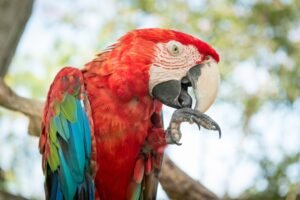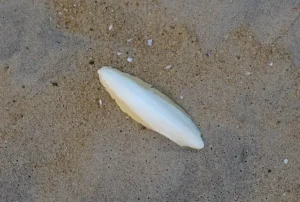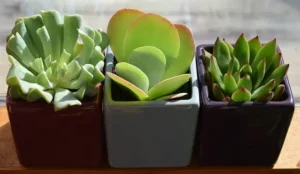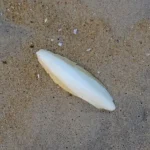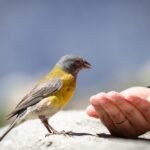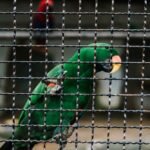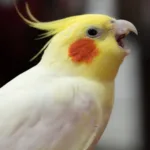Parrots usually have no problem swallowing their food whole, but certain foods and objects can pose a choking hazard.
If your parrot is choking, you first need to identify the cause of choking, whether it’s related to food, an object, or water.
Usually, when the object is stuck in the parrot’s crop, it may be able to cough it out on its own. However, if it does not come out after a few attempts, hold the bird upside down and let gravity do its job. You can also gently press one finger on the parrot’s keel bone while it is inverted.
Quick Navigation
Signs Your Parrot Is Choking
The signs of choking are quite evident when you see them. However, they may differ depending on what your parrot may be choking on. If the parrot is choking on water or has gooey food stuck in its mouth, it may behave distressed for a longer period and the signs may be subtle.
Gagging
Parrots usually gag when they’re trying to adjust their crop. It looks similar to yawning but with a stretching neck movement. However, if the gagging continues for long, it can be an indication that something may be wrong.
Bobbing Head Up And Down
When a parrot bobs its head while gagging, it means it is regurgitating. They do this to regurgitate whatever may be causing irritation in the crop.
In case, they are not able to get it cleared on the first attempt, they may try several more times to get rid of the blockage, which may further exhaust their energy.
Flapping Wings Frantically
A parrot will flap its wings in agitation to seek attention or call for help. It is when the bird has exhausted its energy in dislodging the stuck object and is losing its breath.
Opening And Closing Its Mouth
Wing flapping is followed shortly after by repeated opening and closing of the beak. Open-mouth breathing is a telltale sign that your parrot is gasping for breath.
What To Do When Your Parrot Is Choking?

Do Not Give Them Water Or Food
During such an emergency, the most common response from most parrot owners would be to give them water or some food. While you may think that water could help wash down the food that is unable to go through the esophagus, it may not be the best solution. It may cause the parrot to aspirate which can lead to further problems.
Wait For The Parrot To Cough It Out
If your parrot does not appear to be panicking in the immediate moment, you should give it a few moments as it tries to regurgitate. When a parrot has any kind of irritation or obstruction in its crop, it often regurgitates to clean the crop which can get rid of any blockages.
Assist Them
If you see that your parrot is unable to dislodge the object, here’s what you need to do:
- Hold the parrot upside down while allowing its head to naturally hang downwards. When you hold the parrot inverted, gravity can assist in moving the object from its place and letting it fall back down.
Wait for a few seconds. If it does not work, try this technique:
- Apply gentle pressure to its keel bone located at the center of the chest. Use one finger to press softly on the keel to create a slight compression. This may help dislodge the stuck item. However, it’s crucial to exercise caution while doing this since parrots are fragile creatures.
Call The Vet
In some cases, the object is lodged deep in the parrot’s trachea, and there is not much that you can do at home. In such a situation, it is crucial to take your bird to a nearby vet as quickly as possible. The vet will surgically place an air sac tube to provide oxygen to the parrot and determine where the object is located.
Whenever you have a choking situation with your bird, you should immediately go to the vet. A lot of time can be wasted trying to determine what it could be that is lodged inside the throat, which could be used to save your parrot’s life if you take it to the vet in time.
Even during a minor case of choking, you should have your parrot examined to find out why it has happened or if anything has been left off there. In many cases, the object cannot be found in the upper respiratory tract and requires surgery for removal.
Can You Do A Heimlich Maneuver On A Parrot?
Birds do not have a diaphragm like humans do. Instead, they rely on muscle movements to expand and contract their body cavity, which helps them breathe. Due to this anatomical difference, the standard Heimlich maneuver is not an appropriate technique to be used on parrots.
Things That Are A Choking Hazard For Parrots

Small Toys
Parrots routinely chew on things kept in their surroundings, including their toys. They may bite it from time to time but as a solid object, there is not much chance for the parrot to swallow it. But if the toy breaks or is small enough for the parrot to ingest, it can possibly get stuck inside the parrot’s throat.
Certain Foods
It can be hard to keep your parrot from eating the foods they like. But you should avoid giving them foods that are hard to break or have a sticky texture.
An example of hard food would be nuts. While parrots are capable of breaking the hardest foods using their beak, sometimes the pieces may still not be small enough for them to easily swallow and they may end up choking on it.
Similarly, foods with a sticky or gooey consistency like raisins, peanut butter, or some fruits should only be offered to parrots in moderation. These foods may not lodge but rather, get stuck inside the parrot’s mouth or throat.
Household Items
There’s almost no object or thing around the house that your parrot will abstain from putting its beak on. It is a natural behavior for parrots to explore their environment. But sadly, this is also one of the reasons they often get themselves into trouble.
Many small objects like paperclips, cotton bobs, and broken pieces of plastic can be easy for parrots to find and chew on. To counter this issue, you can try to keep their surroundings free from any such item and also consider the possibility of choking for each new toy you get them.
Water
Choking on the water is dangerous for two reasons. First, the inability to breathe of course, but parrots usually resolve that issue on their own by regurgitating repeatedly. But because of this, they run the risk of accidentally inhaling the water into their lungs, which can cause aspiration pneumonia and other respiratory problems.
For baby parrots, however, choking on liquid formula may be a very serious issue, due to their fragile bodies. Baby parrots are usually more susceptible to choking incidents from liquids or when transitioning to solid food.
They may not be able to survive for long if the oxygen supply is cut off abruptly. So it’s always important to be careful while feeding them and careful not to push the syringe too close to their throat when hand feeding.
How To Prevent Choking In Parrots?
Whenever your parrot finds something that fits the size of its mouth, it will likely try to eat it. So it is important that you take the necessary steps in preventing a choking incident with your parrot.
- Offer appropriately sized food
- Keep small household objects out of their reach
- Choose bird-safe toys without small detachable parts
- Keep a watch on them while they are out of their cage
- Keep their cage and surroundings clean
- Regularly inspect for broken toys
Things That Can Be Confused As Choking
Parrots gag for a number of reasons which may give the appearance of them choking on something. These are some of their behaviors that might be perceived as choking.
Crop Adjusting
This is probably the most common parrot behavior that freaks out new owners. During crop adjusting, parrots open and close their mouth which can look like they are gagging excessively. But actually, it is a normal thing for parrots to do.
Parrots have a pouch that stores additional food while the rest is being digested in the stomach. This pouch is called the crop. From time to time, parrots may adjust their crop to make space for food.
Regurgitation
Regurgitation in parrots is when they bring partially digested food back up from their crop. It’s a natural behavior used for bonding, feeding young, or showing affection.
They do this usually by bobbing their head up and down and extending their necks, causing the food and saliva to come up from their crop. However, as they are doing it, it can sometimes give the appearance of choking.
Vomiting
Vomiting is different from regurgitation. When a parrot is throwing up, it is the forceful expulsion of liquid content that comes from the stomach. The movements are abrupt and the liquid usually falls on the parrot’s face when it ejects out of its mouth. You may also see the parrot shake its head and feathers to wick away the vomit.
Coughing
Parrots can cough for various reasons, such as clearing their throat or imitating human coughs. They also make a subtle coughing sound while adjusting their crop.
Mostly, it is not a big issue when you hear your parrot cough, although you should observe their behavior and see how long the coughing lasts.
